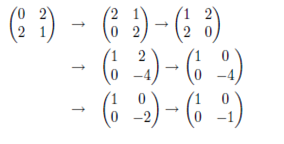SKEDSOFT
Diagonalisation of Matrices:
Two matrices A,B ∈ Mn(K) are congruent if there is an invertible matrix P ∈ GLn(K) such that,

We have shown that if B and C are two bases then for bilinear from f the matrices [ f ]β and [ f ]c are congruents.
Theoerem: Let A ∈ Mn(k) be symmetric where k is a field in which 1 1 ≠ 0, then A is congruent to a diagonal matrix.
Proof : This is judt the matrix version of the previous theorem. We shall next find out how to calculate the diagonal matrix congruent to a given symmteric matrix.
Recall : There are three kinds of row operations:
1. Swao rows i and j;
2. Multiply row (i) by λ ≠ 0;
3. Add λ  row (i) to row (j)
row (i) to row (j)
To each row operations there is a corresponding elementery matrix E; then matrix E is the result of doing the row operations to In. The row opeartions transform a matrix A into EA.
We may also define three corresponding column opeartions:
1. Swap column i and j;
2. Multiply column (i) by λ ≠ 0;
3. add λ  column (i) to column (j).
column (i) to column (j).
Doing a column operations to A is the same a doing the corresponding row opeartions to At. We therefore obtain (EAt)t = AEt .
Example: Consider the quadratic form: 

This shows that there is basis {b1,b2} such that,

The last step in the previous example transformed the -4 into -1. In general once we have a diagonal matrix we are free to multiply or divide the diagonal entries by square.